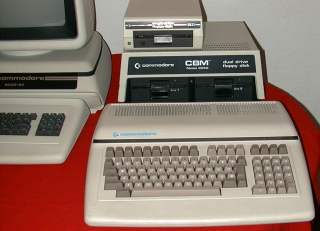
Click on the photo for a larger view. Clicking again on the larger photo will give you the unscaled version in full size.
lda #$43; sta $DD00; dex; bne $424D
In the times, when I started programming computers, "computer" was not a synonym for "Intel". At that time, everybody (worth noting) laughed about Microsoft and their overpriced, featureless software (today, people are no longer laughing, but apart from that, nothing has changed). Real men built their own computers. From scratch. Using a high level language was considered bad style. Real programmers could read the machine code from a hex dump and memory size was measured in kilobytes....
Today, I'm developing software for systems that are several hundred times faster than the ones, I started with. I'm writing my code mostly in C++, a language that did not even exist in the old days - and I'm happy with it.
However, it is nice to remember the old days. This page is about my memories and the computers, that live in it.
I'm collecting old computers just for fun. So don't expect anything spectacular. I'm collecting mostly Commodore computers, but I've a special relationship to the 6502 CPU and its decendants, so there are some other 6502 systems in my collection.
I've several duplicate computers, peripherials and literature for sale or swap. See this page for a list (note: since shipping outside of germany is probably too expensive, the swap page is in german language).
Here are a few unsorted photos from my collection. For more photos of specific machines, see below.

|
Several Commodore business computers and peripherials. The nice
looking computer in the front is a CBM 610
(see below), in the rear a 8050 dual floppy
drive and a 2031 single drive. On the left (only partially visible)
a 8032SK.
Click on the photo for a larger view. Clicking again on the larger photo will give you the unscaled version in full size. |
For the more technical people, I've created a few pages in which I will have a closer look at and inside some parts of my computer collection.
Beware: The pages have many pictures and loading may be slow.
All pictures were taken with a Nikon CoolPix900 digital camera in normal mode. The camera creates pictures with 1280x960 resolution. The images were color adjusted and cropped using The Gimp, a cool image manipulation program running under Linux. The pictures in the text are scaled to a width of 320 pixels. Clicking on the pictures will give larger versions (640 pixels width). These images are in turn linked to the original (cropped) images in full resolution.
CBM P500 CBM 610 (aka B128) The C116 (and the 264 family) The Commodore BTX decoder
One of my computers is a CBM610 (named B128 in the US). Many, many years ago, this was one of my favourite machines. I added lots of memory, a switchable kernal ROM and other fancy stuff. At that time I've also disassembled and documented the kernal and created a custom kernal that is able to talk to serial devices (like the 1541 floppy station) using a small adaptor cable.
At that time I did not care much about non german speaking people, so all comments in the sources are in german. The sources were recently converted from my old DOS assembler syntax to the new ca65 syntax (that was not much work since the syntax is almost identical). The ca65 macroassembler is the assembler companion for the cc65 C compiler.
If you're interested in the sources, you may follow these links:
Disassembly of the original kernal. New kernal with 1541 support. Schematic diagram of the serial interface cable needed. A machine language monitor (including a line assembler/disassembler).
All archives do also contain a binary image, so you don't need to assemble it yourself.
I've also done a port of the cc65 C compiler that was available for the Atari 6502 computers some time ago. Follow this link for more information.
Here are some links to pages that cover old or unusual CBM machines. If you know of more interesting sites, please send me a mail!
| index.php Letzte Änderung: 07-Nov-2018 | Impressum Datenschutzerklärung |